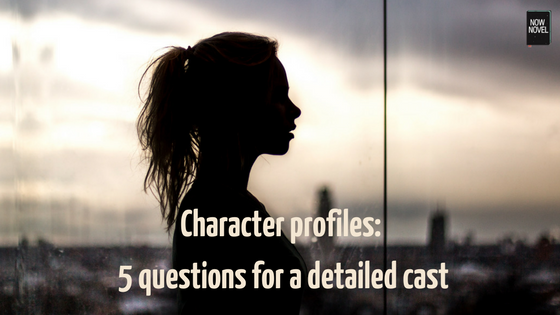Character profile writing is a useful way to build a rounded idea of your characters. Knowing your characters’ appearance and persona inside out makes scenes practically write themselves, sometimes, when you bring characters together. To create a character profile, ask these 5 questions and write summary answers with simple headings (e.g. ‘name’, ‘main goal’):
1. What does your character look like?
Even only a few details of physical appearance can differentiate characters. Avoid focusing on just one or two features (such as eye and hair colour). Instead, ask yourself:
- How does this character dress and what does it reveal about them? Read this guide to using characters’ clothing for characterization
- What is their build, short or tall, slender, average or large?
- What is their bearing/posture like? Do they slouch, or are they upright? What factors produce this? For example, a dancer would be more upright due to posture being part of their vocational training
- What physical traits would make them recognizable in a line-up or group scene? (Scars, limps, out-of-symmetry physical features and other details)
- How do they move? Picture a man who skips leg day at the gym, for example, and moves from his shoulders, walking with a swiveling stride.
It’s likely you won’t need to include every element of description you plan when creating a character profile in your actual draft. In fact, it’s unwise to list every single physical attribute when describing a character. Detail is best when it’s relevant. If it’s related to actions, for example. You could describe a character’s hair in the course of her tying it up under a cap so she can perform surgery.
Even though you won’t use every detail, asking multiple questions about characters’ appearances will help you individualize your novel’s cast.
2. What is your character’s personality like (and how has backstory shaped this)?
Memorable, intriguing characters have distinct personalities.
In Gabriel Garcia Marquez’s Love in the Time of Cholera (1985), for example, the love-struck Florentino Ariza is intense and romantic. He waits almost a whole lifetime for a second chance to woo Fermina Daza, the immense, unrequited love of his youth. Knowing this backstory, we could ask, how does this shape Florentino Ariza as time passes?
As an example, Marquez describes the greater caution and care Florentino takes in life as he gets older:
‘Even in his youth Florentino Ariza climbed up and down stairs with special care, for he had always believed that old age began with one’s first minor fall and that death came with the second […] As the years passed, it took him longer and longer to walk up the stairs, not because it was harder for him, as he himself hurried to explain, but because he used greater and greater care in the climb.’
We see the character’s personality evolve, from the recklessness and intensity of his obsessing over Fermina Daza and writing her letters in his youth, to his cautiousness in many areas of life as he grows older. The cautiousness is a fitting detail of this character’s personality. Fear of harm is, as Marquez writes, is there already in Florentino’s youth. This fear grows though, in the wake of personal disappointment.
From the above example, we can see that detailed, interesting characters are full of hopes, goals, disappointments, regrets, and ideas about the world (e.g. the pessimistic notion that falling cues old age which cues death). When you write a character profile, ask:
- What were this character’s most crucial formative experiences?
- How might the character change and evolve as a result of this experience?
These are just some questions to ask about your characters’ personalities. The point is to be curious. Interview your characters as you would interview a fascinating artist or musician. Ask your characters what inspires them, how they got to where they are now, in the time of your story.
3. What is your character’s biggest goal?
Characters’ desires and goals drive plot. Whether your character’s goal is reaching the pinnacle of Everest, cracking a murder case or finding the love of their life, one goal should lie above all others. Having an idea of your characters’ goals and motivations makes it easier to write ensemble scenes, because when characters’ goals converge, alliances form. Alternatively, when goals oppose each other, conflict arises.
Think of some of the strongest character goals in fiction. Quest-like goals in fantasy make for riveting reading, from the hunt to find the legendary Grail in the legends of King Arthur, to Frodo’s goal of destroying the evil One Ring in The Lord of the Rings. To clarify characters’ goals, ask:
- What is the one thing they want to achieve more than any other? Why?
- Does your character know how to achieve this goal? If not, what needs to happen to make this possible? (For example, in LOTR, Frodo needs the geographical, martial and other knowledge of his band of co-travellers to solve obstacles on the path to Mount Doom)
- What external obstacles could make it hard for your character to reach their goal? (For example, a character who wants profound love (like Florentino Ariza in Love in the Time of Cholera) might encounter hostile family of the beloved, which he does)
- What internal obstacles might get in the way? (For example, Florentino Ariza in Marquez’s novel has strong characteristics of melancholy and vulnerability that his feistier love interest finds less attractive)
4. What are your character’s greatest fears and flaws?
Even the protagonist of a rewarding, complex novel has flaws. How a character’s flaws and fears interact with their goals and desires is compelling.
Consider, for example, Florentino Ariza in Love in the Time of Cholera. Because his greatest goal is to win back the affections of his now-older unrequited love, (after her husband passes away near the start of the story), this goal is also a source of fear. Marquez repeatedly describes Florentino’s fear of aging. As he gets older, time is not on his side for rekindling his lost romance. This is why it feels fitting that Florentino frets about small reminders of his vanishing youth, such as the inevitable increasing difficulty of climbing stairs.
When you write a character profile, ask:
- What is the one thing your character fears most? How is this related to their goal? For example, a character whose biggest goal is to finish their degree, whose lower-income parents worked hard to send them to school, might also hold a large fear of failure
- What are your characters’ biggest flaws? Are they cowardly, prone to jealousy, vindictive, quick to anger, slow to take action? There are countless character flaws that can drive your character towards interesting, sometimes counter-productive choices
Creating character flaws (like Florentino Ariza’s stuffy and obsessive nature, which makes him a less obvious choice of lover for Fermina) gives them additional obstacles. These make their paths towards their goals more interesting.

5. What is your character’s type?
It is also often helpful, when writing character profiles, to keep in mind the broader, structural part your character will play in your novel. Detail is important and useful, but also think about what function they serve in the narrative. Are they the protagonist/hero/anti-hero? Or the hero’s antagonist/opponent? Which of Jung’s 12 character archetypes is most dominant in their personality and role in the story? Are they The Lover (like Florentino), seeking the joys of an intimate relationship? Or are they a restless Adventurer who will receive a quest and see it to completion for the sake of their world?
When you create a character profile, to include role and type, ask:
- Why is this character important for the story, what is their purpose for the plot?
- What types of secondary character would bring them closer to their goal, and what types would hinder them? You can turn these secondary character ideas into fully fledged characters at a later stage.
Create detailed, useful character profiles when you use the Idea Finder on Now Novel to gather and refine ideas for your novel.



2 replies on “Character profiles: 5 questions for a detailed cast”
My question would be, “What role, if any, deeply affected you personally, perhaps even changed you in a permanent manner?”
That’s a great question, Tessa. These major milestones give characters’ backstory a sense of depth. Of course, you don’t have to include the answer in detail if it isn’t relevant to the time frame or arc of your story, but if you know these details in the back of your mind it makes your characters more real because you have their formative experiences to inform how they respond to situations and others.